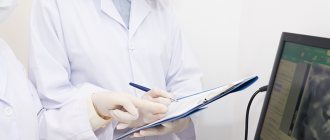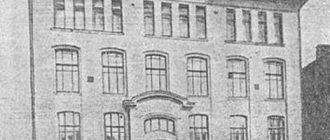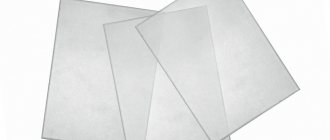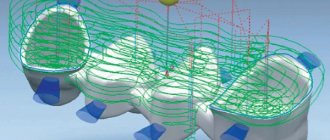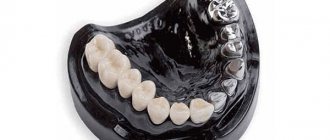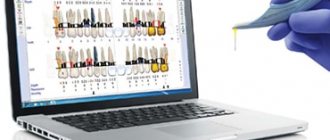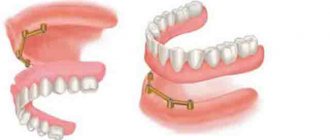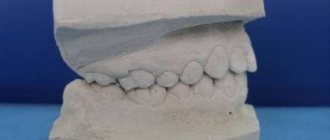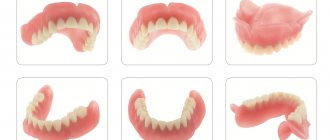Modern dentistry cannot be imagined without accurate diagnostics. A set of measures to establish a diagnosis is indispensable in the treatment of teeth and gums; it plays a key role in implantation and prosthetics, and is also important during orthodontic treatment.
Diagnostics is carried out at all stages of preventive and therapeutic tasks. The dentist-therapist resorts to full diagnostic measures when the patient comes to the clinic. The specialist also uses operational diagnostic measures as an intermediate stage of treatment after installing a filling. Upon completion of prosthetic procedures, full diagnostics allows you to evaluate the results and correct them in a timely manner.
Dental diagnostics is, without exaggeration, 50% of the success of treatment and prevention.
CT scan
This method, which is based on the exponential law of attenuation of radiation for absorbing media, allows one to obtain many points with different optical densities. This is necessary to assess the condition of hard tissues that cannot be examined visually. During CT scanning, teeth, bone and skin surfaces act as a regulator of optical density.
An even more accurate method, compared to CT, is optical scanning (up to 5 microns, which is much more accurate than 300 microns in tomography). This technology is necessary for visualizing soft tissues, including the gingival surface, in a 3D scene of the dentofacial system.
How complex digital diagnostics are carried out
The most popular area for digital diagnostics is complex dental implantation with the installation of a complete fixed bridge prosthesis 1-3 days after surgery. Getting teeth back so quickly is quite a difficult task. After all, as a rule, the remains of patients’ own teeth are in poor condition or missing, and the bite is disturbed. The implant surgeon and orthopedist need to re-create the balance of the entire jaw system. But it is impossible to do this right away; muscles and joints need time to rebuild. That is why there is a so-called adaptation period or adaptation prosthesis, through which orthopedists set the vectors of change in combination with the necessary balance of load on the implants. As a result, in addition to aesthetics, prostheses must normalize the position of the joint and the functioning of the facial muscles - and such a large-scale task cannot be solved without careful functional diagnostics and planning.
Comprehensive functional diagnostics is important not only when installing an adaptive fixed prosthesis, but especially when replacing prosthetics. A permanent prosthesis on implants lasts for decades, but only if it functions without overload.
However, a detailed analysis of the initial situation is useful in any orthopedic treatment: when installing veneers, crowns, bridges, etc. Any intervention in the shape of the teeth shifts the balance - the chewing load is distributed slightly differently, the facial muscles are tensed differently, and the movement of the joints changes. Will these changes be for the better or will they lead to structural failure and complications? This can be done
Scanning methods in prosthetic dentistry
There are several 3D scanning techniques, each with its own pros and cons. All of them are divided into two large groups:
- contact or mechanical;
- contactless or optical.
Optical scanners are more in demand in dentistry than mechanical ones, since they spend less time scanning and work more efficiently with large objects. In addition, they allow you to obtain a three-dimensional texture - the characteristic color of an object.
Study of muscle activity using a myograph
A myograph is a device that helps to study the bioelectrical activity of the muscular system. We use a Protens device, which is both a myograph and a tens device. That is, it allows not only to obtain data on the state of certain muscle groups in the facial area, but also to adjust activity and reduce tension.
The device is very miniature - it is fixed on the neck and has sensors that are located in the area of the temples and temporomandibular joints. To take data, you just need to move your lower jaw for a few minutes and just talk to the doctor. The device reads the data and transfers it to the computer, loading it into a special program.
Photogrammetry
This technology stands somewhat apart from optical scanning. It offers high performance because it measures the image, not the object. Other benefits include:
- high accuracy;
- strict methods of processing measurement results;
- the ability to study stationary and moving objects;
- remote nature of measurements.
Monophotogrammetry with structured illumination is most often used. The latter represents a certain known pattern projected onto an object. To build a three-dimensional model, they take the distortion when projecting onto the object.
What is the advantage of digital diagnostics over conventional ones?
Digital diagnostics essentially repeats the standard scenario - we read the patient’s individual parameters and create a model copy of his jaw system. But the entire process takes place digitally, from impressions to a complete recreation of your appearance, replicating the functioning of your jaw system. This is very convenient for the doctor and the patient, and also provides many advantages over mechanical devices and equipment of the old generation.
- We make an accurate diagnosis. Using innovative equipment, we identify the smallest disturbances in the functioning of the dentofacial apparatus.
- We apply an integrated approach We collect and analyze data from different types of diagnostics in a single virtual space
- We solve even complex cases Thanks to high-quality functional diagnostics, we restore even complex bite relationships
- We give a predictable result We create functional dentures and restore the natural healthy position of the jaws
High diagnostic accuracy
Digital equipment takes into account several hundred different parameters when scanning and processing patient data.
The output is a detailed and individual picture without average values. Digital equipment operates according to clear algorithms - the models almost perfectly copy the patient’s jaw system directly into the computer’s memory. And when working with mechanical equipment, much depends on the doctor’s ability to correctly find control points and landmarks and take clear dental impressions. It is easy to make minor mistakes here and transfer data with minor deviations to further work. It is also necessary to take into account errors due to shrinkage of materials when casting diagnostic plaster models, etc.
Fast data processing
A virtual model of the jaw system is created in parallel with the scanning of the teeth. That is, the data is immediately loaded into the program, and the entire diagnosis takes literally 30-50 minutes. With traditional diagnostics, in order to obtain a similar real model and analyze it, you will have to spend a couple of days taking bite parameters, casting plaster copies of the jaws, as well as their correct placement in the articulator and hardening of the material.
Solving even difficult cases
The capabilities of analog equipment are limited. Thus, conventional articulators are capable of simulating only a certain number of movements of the lower jaw and cannot recreate complex trajectories. Digital devices are able to read complex data, so when analyzing the doctor evaluates not just standard jaw displacements, but the patient’s individual habits. This allows you to solve even the most difficult problems.
Diagnostics in any conditions
Some types of functional diagnostics, for example, axiography using ultrasound equipment, cannot be carried out without errors if there are difficulties with attaching the sensors - when there are few teeth in the mouth, a deep bite, etc. The new generation of optical digital axiographs, which is used in our clinic, allows diagnosis even in the complete absence of teeth. In this case, special templates are created on which the sensors are attached or existing removable structures are used for guidance.
Comprehensive analysis and development of the prosthesis in 3D
All results can be combined in a single space - the Proart (P-Art) program. That is, load into it 3D computed tomography images, digital impressions of teeth, an image of the patient’s face, bite parameters, axiography data with trajectories of movement of the lower jaw - and get a complete clinical picture. Without such innovative technologies, the orthopedic dentist is forced to work through individual parts of the data in many different programs, or even rely only on physical models and his own experience.
Visual: you can see the results even before treatment
The program recreates a digital copy of the patient's face - teeth, jaws, joints, muscles and even appearance. It can be analyzed layer by layer, from any angle, still or dynamic. Thanks to such visualization, the doctor can not only explain, but show the patient the treatment plan and the predicted result. The model can also be used to develop aesthetics in digital smile design programs.
Patient convenience
Digital diagnostics are carried out using lightweight and miniature devices - externally these are small sensors, plates, hoops. They are easy to put on and take off and can be adjusted individually for each patient. Diagnostics is carried out comfortably, without lengthy setup and complex fixation of equipment.
We guarantee: the dentures will be an exact copy of your natural teeth! We develop prosthetics using 3D technologies and robotic equipment and get results that will please you for many years.
Free consultation
Optical strip scanning
This technology shows better results compared to the above. A special grid or stripes are projected onto the object. Based on their distortions, the relief of the scanned surface is determined. In this case, it is enough to determine the coordinates of the object’s surface using one camera and additional structured lighting. This approach is most often used in modern orthopedic dentistry.
Structured light can be different - laser, infrared, visible. The main condition is automatic recognition of these lines by software. The known distance between the projected stripes allows you to calculate the coordinates of the surface points. The more lines, the more accurate the result will be. The more cameras are used, the higher the scanning speed will be.
Diagnostics involves the following activities:
- History - information about the problem from the patient himself. Mandatory primary stage of diagnosis. The patient indicates the area of concern - which tooth hurts, where there is increased sensitivity, etc.
- Introduction to medical history . Modern technologies make it possible to provide a specialist with images and examination results taken earlier. The information in the medical history card can greatly facilitate the doctor’s work when developing the optimal treatment strategy, so it is important to have it with you whenever possible.
- A thorough visual examination and examination of the condition of the teeth and gums. The specialist determines the problem by the appearance of the tissue.
- Instrumental (X-ray) examination is a study using special equipment. A key element of modern dental diagnostics.
X-rays of teeth
Types of scanners
- Stationary, or extraoral. They appeared earlier than the others and became widespread. The scanning field is 80 x 90 or 90 x 90 mm, which covers the plaster model of the entire dentition. Some modifications have limited scanning height. Accuracy – 5-15 microns.
- Intraoral. They appeared later, but are actively replacing their extraoral counterparts. Such scanners save the dentist’s time, since with their arrival in the dental laboratory there is no longer a need to stir the plaster and wait for it to harden, install pins, make collapsible models, and plaster them for scanning. However, intraoral scanners are still inferior to stationary scanners in accuracy (their indicator is from 30 microns).
- Facial. These devices stand apart from the previous ones and allow you to obtain a three-dimensional image of the face for planning the treatment of pulpitis, periodontitis, caries, taking into account aesthetic requirements.
The emergence of new diagnostic devices in orthopedic dentistry has simplified the doctor’s task and also reduced the time required to make a diagnosis and draw up a treatment regimen. Three-dimensional technologies have significantly increased the accuracy of therapeutic and orthopedic manipulations at all stages of exposure.
X-ray diagnostics
The use of X-rays and other high-precision equipment in diagnostics allows us to obtain, in real time, accurate images of the desired areas of the oral cavity in optimal resolution.
What equipment is used for instrumental diagnostics:
- Radiovisiograph (visiograph, videograph, dental imaging apparatus) is a device that converts X-ray data into a digital image on a computer in real time. The dentist, using a visiograph, controls the treatment procedure without leaving the chair with the patient. The device allows you to quickly take a photo and obtain an image of the problem tooth.
- Digital 3D orthopantomograph - allows you to take a panoramic image of the desired area of the skull or an individual tooth. The device is indispensable for prosthetics, treatment, implantation, bite correction (orthodontics), etc.
- Rheodentograph is a device for accurately assessing the functional state of the pulp (tissue containing nerve endings) of a tooth according to hemodynamic indications. Allows you to quickly, painlessly and accurately determine the extent of tissue damage. The device is important in the gentle treatment of pulpitis.
- A tool for diagnosing early and latent caries. Pathological processes of hard tissues in the early stages are often difficult to determine. At the same time, treating caries in the early stages allows you to solve the problem with minimal impact on the tissue. The device allows you to effectively identify crisis areas on the tooth.
The capabilities of the equipment allow you to print the results or transfer them to electronic media.
Diagnostic measures include control modeling methods, as well as taking impressions. These methods can significantly increase the effectiveness of orthodontic treatment and prosthetics.
The main task of the dentist is to maintain the health of teeth and gums, maximize tissue preservation, and ensure functionality and aesthetics. All these problems cannot be solved without competent dental diagnostics.
Orthopantomogram, panoramic image
When you have some kind of local problem, of course, you can and should take a targeted photo. But since all the teeth and nerve endings in the mouth are connected, you may think that one tooth hurts, but the problem is actually somewhere nearby. That is why all professional doctors take a panoramic photograph of the teeth during the initial diagnosis in dentistry. And this “panorama” represents your entire dentition and allows you to see the existing problems in their entirety.
The panoramic image clearly shows both jaws, it is possible to draw conclusions about the condition of the teeth and roots, skeletal system and paranasal sinuses, and diagnose defects in bite, location and shape of teeth. Having received an orthopantomogram, the doctor will see caries at any stage, periodontal pockets, fibromas, granulomas and cysts, latent inflammation, possible changes in the condition of the temporomandibular joint, unerupted wisdom teeth, and sinusitis. A panoramic photograph is necessary before implantation, prosthetics, orthodontic treatment, surgery (complicated removal of wisdom teeth), complex treatment of periodontitis and periodontal disease.
Removing bite parameters - axiography
Afterwards, the state of the bite is determined, that is, the position of the jaws relative to each other, and even the trajectories of movement of the lower jaw relative to the upper are read. To do this, we use the Proarc digital facebow – separately or in combination with the Proaxis optical axiograph.
The facebow consists of a bite fork and a central sensor. This device is less bulky than classic face bows. It is used both independently (to obtain digital data and use it with an electronic articulator) and in combination with a traditional arch and impression material for bite registration. In the second case, after taking impressions, plaster models of the patient’s jaws are created for further work with mechanical (classical) articulators.
On the left is a conventional articulator, on the right is a digital one
An optical axiograph is a hoop with a camera that is placed on the patient's head. The device is complemented by two small sensors with markings, which the patient bites on - this is how they are “attached” to the upper and lower jaws.
To set the initial position of the teeth, the digital facebow is first activated in the mouth. Then it is removed, and the doctor asks the patient to open and close his mouth, move his lower jaw in certain directions, say a short phrase, or even chew something. A camera directed along the face tracks the position of the sensors and, based on these movements, draws trajectories of movement of the teeth and articular heads.
For the patient, these “dashes and lines” are unclear, but they can tell the doctor a lot about the condition of the temporomandibular joint. And also, in combination with bite parameters, suggest a new correct position of the lower jaw. These data can be freely recalculated relative to any plane, taking into account the anatomical landmarks of the skull, and both virtual and real articulators can be programmed for further development of the shape of the prosthesis.
X-ray diagnostics in dentistry
A targeted photograph in dentistry is used if the problem is localized. In Dental Guru clinics, radiography is performed using modern digital innovative devices, where the dose of radioactive radiation is reduced to a minimum, and radiology in dentistry is absolutely safe. The radiologist will wear a special lead apron for your protection. The shooting sensor is located in the mouth or on the front side. The procedure is painless and takes a few seconds. The final image will show the doctor the condition of the diseased tooth and adjacent teeth.
Using an x-ray, you can see caries, bite defects, jaw fractures, areas of infection in the root canals, abscesses, tumors, cysts, incorrect placement of wisdom teeth and other pathologies. X-rays show hidden caries under a filling, crown or on the root.
Signs of caries on x-ray:
- The spot looks like an area with some darkening of reduced density.
- Medium and deep – reduced surface density due to enamel damage.
- Deep – deformation of the tooth structure with granulomas (areas of inflammation, proliferation of connective tissue) and hardening in the pulp
Diagnosis by palpation
The palpation method is often used in dental practice. During the procedure, the doctor feels the muscles of the head and neck, thus determining their general condition. Disturbances in the functioning of this muscle group indicate the development of pathological processes in the dental system.
What palpation reveals:
- development of disharmonic processes in the work of the muscular system;
- the reason for the violations.
As a result of bilateral palpation, the dentist receives valuable information, which, together with data from other diagnostic methods, allows us to clarify the picture and draw up an optimal treatment plan.
